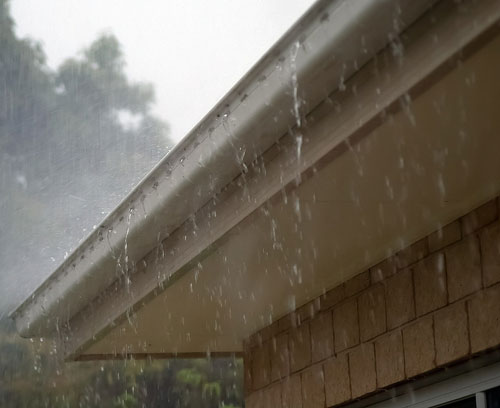 If your roof leaks during heavy rain…
If your roof leaks during heavy rain…
It’s important to find the cause of the problem.
As soon as possible.
So the roof leak can be fixed before more damage occurs.
Today, we’re going to help you identify what may be causing your roof leak and look at possible remedies.
It’s important to understand.
…That any roof leak is an urgent situation.
Because, even if your roof leaks only when rains hard… Left unchecked (and unfixed), roof leaks can cause major damage.
Especially the slow ones.
PLEASE BE SAFE – If you are a homeowner, and you don’t feel comfortable on your roof, please don’t hesitate to contact a professional. Many offer a free inspection or emergency roof repair services. Never climb on your roof while it’s raining.
Slow Roof Leaks = Big Water Damage
The bad things about slow roof leaks – the kind that only show up when it’s raining hard outside.
Is that.
In addition to the obvious (drywall and paint damage), when we look above your ceilings and behind your walls, you could be dealing with mold issues or structural problems with rotted wood.
Slow roof leaks sometimes show up in the strangest places too – like water leaking from wall outlets or light fixtures.
Sometimes water leaks behind walls and leaches straight into your hardwood floors or floor underlayment and causes damage there as well.
During a hard rain, you might also see:
- Water leaking behind your gutters
- Wet spots or damp wood inside attic on roof sheeting or rafters
- Bubbling paint around electrical outlets
- Damp or dripping drywall around light fixtures
- Moisture above or below your windows
- Or maybe you hear some faint dripping in the bathroom vent or chimney
Slow roof leaks can be deceptive, because what you see might seem minor. But what you can’t see might be devastating.
Common Areas of Roof Leaks During Rain
If your roof leaks when it rains hard, you may have an issue in any one of the following areas.
1. Skylight Leaks
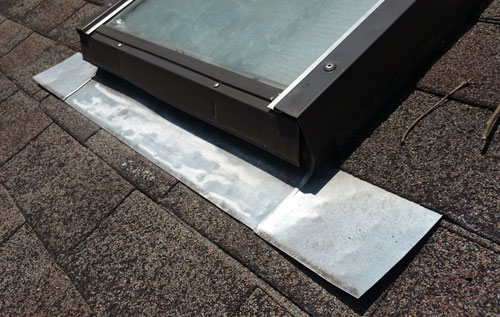 Skylight leaks in heavy rain are a common source for roof leaks.
Skylight leaks in heavy rain are a common source for roof leaks.
During installation, each skylight essentially creates a big hole in an otherwise uniform roof surface.
No matter how well your skylights were installed, it is still possible for them to leak during heavy rains. Especially as your home ages a bit.
Although skylights are designed to shed water, the upper edge of your skylight is a flat surface, against which rainwater flows during a hard rain.
It’s also a location that can hold snow or ice and catch twigs, leaves or other debris that may have fallen on the roof. Over time, flashing and seals get worn out.
Leading to roof leaks around skylights.
Keep in mind that water leaking from skylights may not be wholly attributed to roof leaks from rain. Some skylights leak from condensation or from other water leaks that have traveled down rafters inside the attic.
POSSIBLE SOLUTIONS
- Flexible roof sealant- apply flexible roof sealant from a can or tube to holes, gaps and loose shingles
- Silicone caulk – apply 100% silicone caulking to the skylight window or lens to fix any leaks between the window and the frame
- Flashing & shingles – replace the flashing and shingles around the skylight, creating a good new water barrier
2. Chimney Leaks
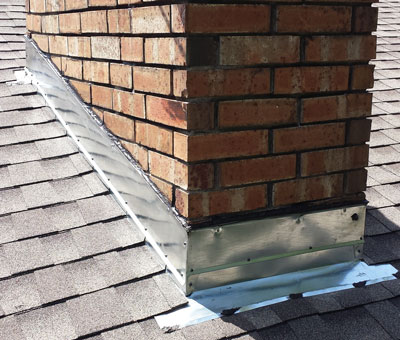
New Chimney Flashing & Sealant
If your chimney leaks when it rains, you may have one of several different problems.
It could be that your chimney cover is damaged or otherwise not working properly. Or perhaps the chimney crown is cracked or leaking.
Or maybe you have cracks or gaps in the mortar or chimney veneer.
But if you have problems with water leaking around the outside of your chimney down into your walls, you may have a problem with worn out flashing or sealant.
Or you may have a poorly designed valley at the bottom of the roof slope (and directly above your chimney) that catches debris, snow and ice…
And allows water to pool and sit during or after a rain.
That leads to more rapid deterioration of flashing and sealants and allows water to leach into your home.
POSSIBLE SOLUTIONS
- Chimney cover – a new chimney cover may keep water from entering the top of the chimney
- Flexible roof sealant- apply flexible roof sealant from a can or tube to holes, gaps, flashing and loose shingles around chimney
- Flashing & shingles – replace flashing and shingles around the chimney, creating a good new water barrier
- Cricket installation – a chimney cricket redirects water away from the valley formed by steep slopes and away from the chimney
Example of Chimney Cricket Repair

3. Vent Pipe Leaks
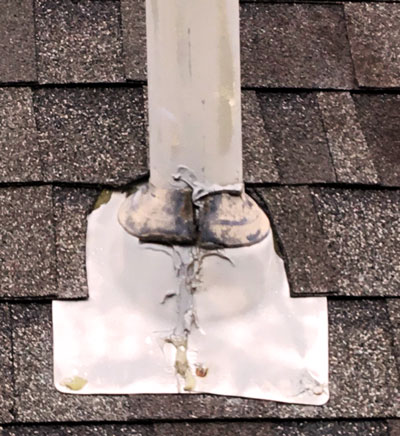 Vent pipes penetrate all the way through the roof in several locations of the house, and each one needs to be maintained to keep water out.
Vent pipes penetrate all the way through the roof in several locations of the house, and each one needs to be maintained to keep water out.
Vent pipe leaks during heavy rain can occur if you have cracks in your vent pipe boot or flashing.
When your roof was installed, each vent pipe received a flexible boot to seal water around the round surface of the vent pipe.
These boots vary in quality, flexibility and longevity.
And over time… many vent pipe boots get hard and brittle as the punishing hot and cold cycles of sun, snow and ice take a toll on your roof.
When the vent pipe boot cracks, your roof is open to a water leak.
If your roof was constructed with cheap quality vent pipe boots, these will likely need more maintenance and replacement over the lifetime of your roof.
Vent pipes are roof maintenance items that should not be overlooked. Periodic maintenance can prevent roof leaks.
POSSIBLE SOLUTIONS
- Flexible roof sealant- apply flexible roof sealant from a can or tube to holes, gaps, flashing and loose shingles around vent pipe
- Vent pipe boot – overlay the old vent pipe boot with a new vent pipe boot, caulk & seal (watch video below)
- Flashing & shingles – replace worn out vent pipe flashing, boot and shingle around it to provide a long-lasting fix
4. Roof Vent Leaks
Roof vents serve an important purpose. They allow air circulation under your roof and allow air inside your attic to circulate with the air outside your attic.
This keeps your attic cooler in the summer and helps extend the life of your roof.
Roof vents come in a variety of styles. You may have a ridge vent, turbine vent, powered air vent or free air vent.

Most air vent styles prevent direct intrusion of water.
But some roof air vents sit fairly flat to the roof, with a mushroom style hood and unprotected sides.
And on occasion a hard driving rain with whipping wind will cause roof vents to leak water. If your roof vent leaks during heavy rain, the rain may be blowing up under the hood and into the vent.
It this is the case, you need to create a breathable shield to slow the driving rain drops while still allowing air flow. This video shows one possible way to do that.
However, as with other roof penetrations, you may have a problem with holes or cracks in your flashing or sealant. Or the vent hood may be damaged in some fashion.
POSSIBLE SOLUTIONS
- Screen wire – use metal screen wire to form a barrier around the outside of your vent hood to stop driving rain
- Flexible roof sealant- apply flexible roof sealant from a can or tube to holes, gaps, flashing and loose shingles around vent
- Flashing & shingles – replace worn out roof vents and shingle around it to provide a long-lasting fix
5. Damaged Shingle Leaks
If you notice water spots on your ceiling after rain, you may simply have damaged or missing shingles.
Shingle damage could come from sun exposure, wind, hail, falling debris, ice or just plain age.
Take a look at your roof.
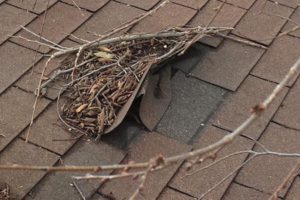
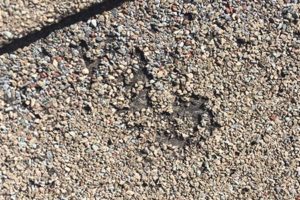
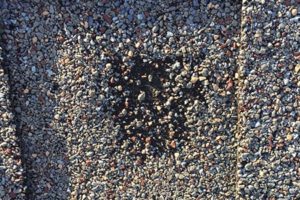
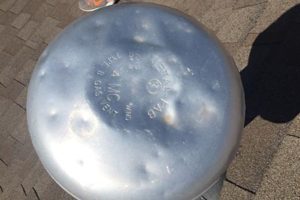
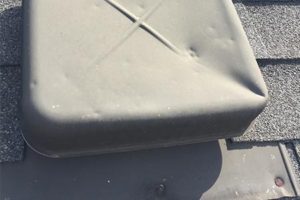
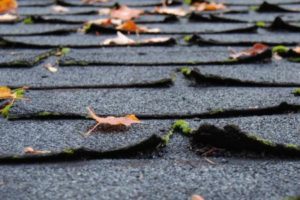
If you notice any spots where granules are missing from the shingle surface, you may have hail damage.
Shingle hail damage can leave a crack in shingles over time and result in roof leaks.
Also take a look at roof vents. If you notice dents or chipped paint, that’s often a good indication that you may have roof hail damage.
If you notice large darker areas of of the roof, you may have had shingle blow off during a strong wind.
And if you have tree branches, leaf piles or other debris laying on your roof, you may have a hole in your shingles from falling branches.
Or you may have an area on your roof where water pools during heavy rain.
POSSIBLE SOLUTIONS
- Remove debris – remove all debris from the surface of your roof and inspect to see if you have shingle damage
- Flexible roof sealant- apply flexible roof sealant from a can or tube to exposed nail heads, holes, gaps and loose shingles
- Shingles – replace missing shingles or damaged shingles if in a small area
- Roof replacement – if you have hail damage or wind damage, talk to a qualified roofer about replacing the roof
6. Roof Valley Leaks
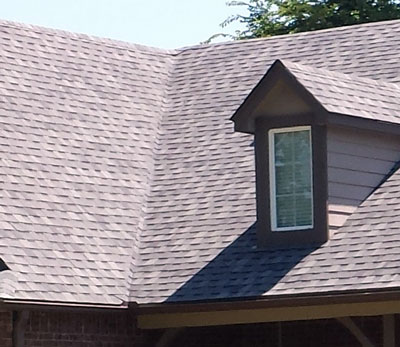 Valleys in your roof are locations where two roof planes intersect and form a “V” shaped valley that runs down a slope of your roof.
Valleys in your roof are locations where two roof planes intersect and form a “V” shaped valley that runs down a slope of your roof.
They are common on both hip and gable roofs.
Valleys can be especially troublesome, because they carry a lot of water during heavy rain.
And during the wintertime, roof valleys may be hold snow form the primary exit path when snow is melting.
They also may be prone to forming an ice dam, which can cause bigger problems.
If your roof valleys are shallow or flatten out near eaves, and you have any type of debris sitting in them…
The blocked valley creates a place for water to slow down and pool instead of running completely off the roof.
Some homes do not include a separate ice and water shield in the valleys. Add to this that some roofers improperly place roofing nails near seams and low spots in the valley.
POSSIBLE SOLUTIONS
- Remove debris – make sure your roof valleys are clear of debris
- Re-shingle valleys – valleys may need to be reshingled, with new ice and water shield put in place
7. Clogged Gutter Leaks
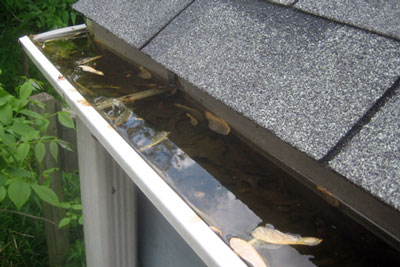 When your gutters are clogged, water is not able to flow away from the edge of the roof.
When your gutters are clogged, water is not able to flow away from the edge of the roof.
This can allow pooling near the edge of your roof and can lead to water leaking into the eave areas of your house and down into your walls.
Especially during heavy rain.
In addition to potential roof leaks, clogged gutters can cause foundation damage, exterior wall damage and damage to your yard or landscaping.
Another problem that may occur with gutters over time is separation from the house. If water does not flow properly over the eave and into your gutters, you may have water leaking behind the gutter and leaching into your walls.
POSSIBLE SOLUTIONS
- Remove debris – remove all debris from gutters & downspouts
- Gutter shield- install gutter shield to prevent leaves and debris from re-entering the gutters
8. Window Leaks
The source for window leaks can be tricky to diagnose.
If you notice a window leaking during rain, it could be a window leak.
Or it could be a leak caused by your home’s brick veneer or siding. Even a pinhole leak in brick mortar can allow water to leak behind the brick.
Or it could be a roof leak…
That has traveled down inside an exterior wall and is leaking around the window.
Keep in mind that roof leaks may start much higher on the roof than the location where they appear. It could be that a vent is leaking further up on the roof, and the water is traveling down a rafter before entering the wall.
POSSIBLE SOLUTIONS
- Flexible sealant- apply flexible sealant to cracks or holes in the brick mortar or home siding
- Shingles – replace missing shingles or damaged shingles if caused by a roof leak
- Vents & flashing – examine vents or flashing higher up on the roof for gaps, cracks, damage
9. Flat Roof Leaks
Flat and low slope roofs can be susceptible to certain types of roof leaks.
Older flat membrane roofing systems may have troubles where the membrane seams have separated.
Or perhaps the flashing around the edges of the roof and parapet have separated.
These issues can cause flat roof leaks during heavy rain.
Another problem we see with flat roofs is that they may have areas of ponding water.
Ponding water could be due to improper roof design.
Or a bad roofing installation that does not provide slope for water to flow off the roof.
Or it could be caused by rotten or worn out decking materials.
Whatever the issue…
If your flat roof leaks, you will want to get it repaired as soon as possible.
We hope this guide helps you discover the source of your leaky roof while it’s raining. If it’s raining right now, take a peek in your attic and look for wet wood and dripping water. See if you can follow the path of the water to find out where the leak originates. Find a local roofer that specializes in roof leak repair, so they can help you get the problem taken care of before the roof leak causes any more damage to your property. Be safe.
Need Help?
If you need professional assistance to help identify the source of your roof leak, contact your local roofing company. In addition to diagnosing the problem, a qualified roofer will be able to offer a safe, affordable and long-lasting solution to keep your home dry during heavy rains.
If you live anywhere near Tulsa, Oklahoma, we would be happy to provide a FREE roof inspection and roofing estimate. Just call (918) 250-7663! We’ll be glad to help.
